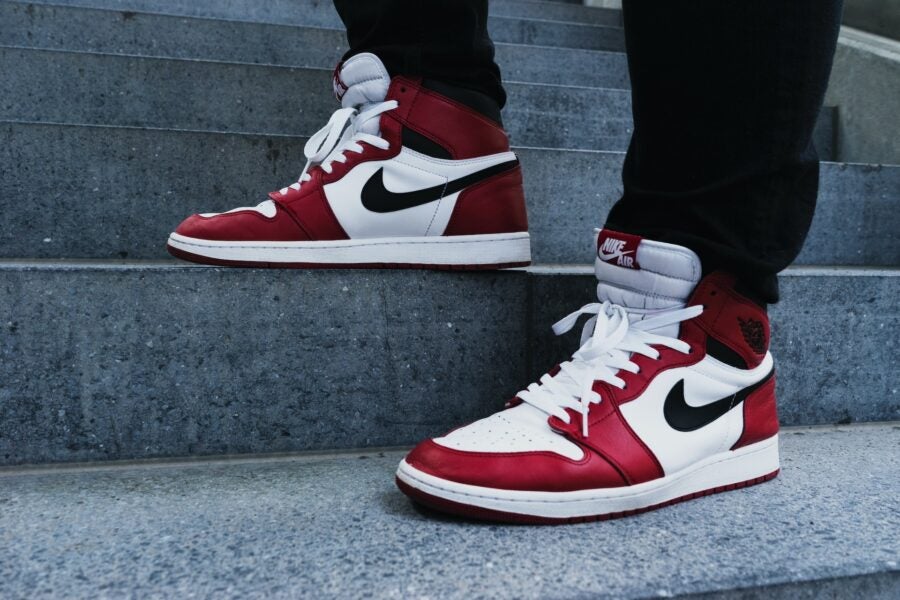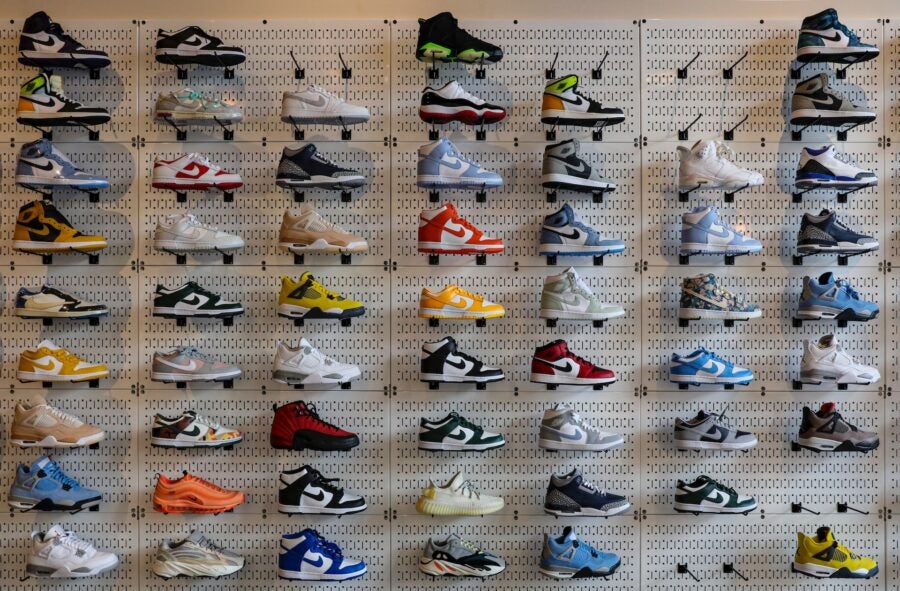
Over the past couple of months you may have seen the trailers for Ben Affleck’s new movie, Air, which gets its UK cinematic release this week.
With an ensemble cast featuring Affleck himself, Matt Damon, Jason Bateman and Viola Davis, the film tells the story of how Nike created the Air Jordan brand. If ever a line of sneakers warranted a biopic, it’s this one, given that it generated nearly $5bn (about £4bn) in sales last year alone, according to Forbes.
In 2022, Nike was the most valuable clothing company in the world
Nowadays, it’s hard to think of Nike as anything other than a sportswear giant. In 2022, Brand Finance ranked it as the most valuable clothing company in the world, worth an estimated $33.2bn, ahead of Louis Vuitton ($23.4bn), Gucci ($18.1bn), and Chanel ($15.3bn).
But the 1980s didn’t start well for Nike. After it went public, the firm posted its first losing quarter and Wall Street, at one point, even had the share price down to single digits.
Things got so bad that Nike had to dump millions of pairs of shoes for as little as a dollar each just to stay afloat. Workers were laid off. Budgets were cut. The company was engulfed by crisis.
Investing in the unknown
But attack, they say, is sometimes the best form of defence. Where Nike might have been tempted to continue a strategy of scaling back, it chose instead to gamble on one really big deal.
Sonny Vaccaro, who is played in the film by Damon, was a Nike marketing executive with the task of seeking potential sponsorships. And in 1984, he stumbled upon a miracle: a rookie basketball player by the name of Michael Jordan.
At the time, Nike was primarily viewed as a running brand. The basketball market, meanwhile, was led by Converse, Adidas and Reebok, which were worn by most of the top players.
Vaccaro saw this as an opportunity. Nike could offer Jordan something that the other brands couldn’t: a line that was just for him, built on his own unique style and image.
Patrick Kampff, senior strategy director at branding and experience consultancy Siegel+Gale, explains that Nike did well to position itself as a “challenger”. He adds: “Who doesn’t love an underdog? We’ve seen the meteoric rise of startups that, through technology, displaced established players in pretty much any category. That’s investing in the potential of change and a willingness to give the status quo an update.”
Nonetheless, it wasn’t an easy sell. Vaccaro had to convince his bosses, Phil Knight and Rob Strasser, to risk what money the company did have on an unproven, unknown athlete. And he had to convince Jordan, who was being courted by Adidas, to sign for Nike.
He managed to, and in doing so sealed an unprecedented deal. Jordan was given a five-year contract with a base salary of $500,000 a year – more than triple any other such agreement in the NBA at that time. Crucially, Nike also gave him a 5% royalty entitlement on every pair of Air Jordan trainers sold.
Initially, the company forecast that Air Jordan would earn it about $3m over the first four years of the contract. But so meteoric was MJ’s rise that this figure ended up falling laughably short. After one year, Air Jordan revenue was $126m.
In his first season playing for the Chicago Bulls, Jordan won the NBA Rookie of the Year award, and his exhilarating, high-octane performances made him one of the most popular players in the sport.
A branding and marketing masterclass
The Air Jordan brand hit an early snag. The first shoe, the Air Jordan 1, had a red and black colour scheme that didn’t conform to the NBA’s uniform rules.
As a result, Jordan was fined $5,000 for every game that he wore it. But Nike was so invested by this point it just decided to foot the bill.
Air Jordan has become as much a fashion symbol as the leading choice for basketball players
“The NBA ban,” Kampff says, “made Jordan seem like a larger-than-life hero whose legendary status went much beyond the basketball court. Everybody wanted to ‘be like Mike’. The shoe was the instrument to make those dreams come true.”
The fines were a drop in the ocean compared with the money that Nike was making. The company even incorporated the rule-breaking message it was sending into its advertising for the brand.
In the years since, Air Jordan has evolved both on and off the court. As well as shoes, Nike has launched various Air Jordan clothes.
With the help of the iconic Jumpman logo design, which depicts a silhouette of MJ leaping for a slam-dunk, Air Jordan has become as much a fashion symbol as the leading choice for basketball players. Early Air Jordan trainers are viewed as rare collectibles, with some pairs selling for thousands of dollars.

Bahar Shahidi, a senior strategist at DesignStudio, a branding agency, says that the Air Jordan logo succeeds because “it’s complex, detailed and ‘alive’ – at odds with the simplicity that most modern brands today adopt, and unusual within sportswear, too, where you tend to find cleaner, geometric shapes. Instead, this logo shows motion. It’s unexpectedly ‘real’ rather than abstract.”
Nike resisted the so-called blanding trend of the late 2010s, she explains, which involved “the removal of ‘noise’ and detail in logos, with a focus instead on clean lines, simplifications, blending in, and uniformity. This can be seen as overly sanitised and nondescript by critics.”
What can other businesses learn from Nike’s success?
For Kampff, it’s helpful for companies to think small and act big. “Embracing the underdog mentality enables you to reassess your brand strategy in search of hidden opportunities that may not be visible when you’re on top,” he says.
He also urges firms to take more calculated risks. “In today’s ever-changing markets, standing still is usually a losing bet. Which are the bets your brand is willing to place to stay relevant for tomorrow’s customer, in tomorrow’s market?”
And on logo design, Shahidi adds that the key lesson to take from Air Jordan is to strive for “originality, individuality, texture and points of interest that bring soul to a brand”.
The most successful companies, Shahidi suggests, will be those that escape the algorithmic “homogeneity” of overcrowded marketplaces, particularly in the digital age. She points out that luxury fashion brand Burberry has recently reverted to an older logo and typeface, featuring its Equestrian Knight illustration in favour of the text-only logo it introduced in 2018.
Still, it would take something truly special to scale the heights that Nike has attained. Nike co-founder Phil Knight has said on record several times that signing Jordan was the best decision the company ever made. Given the evidence, it would be hard for anyone to disagree.

Over the past couple of months you may have seen the trailers for Ben Affleck’s new movie, Air, which gets its UK cinematic release this week.
With an ensemble cast featuring Affleck himself, Matt Damon, Jason Bateman and Viola Davis, the film tells the story of how Nike created the Air Jordan brand. If ever a line of sneakers warranted a biopic, it’s this one, given that it generated nearly $5bn (about £4bn) in sales last year alone, according to Forbes.
In 2022, Nike was the most valuable clothing company in the world
